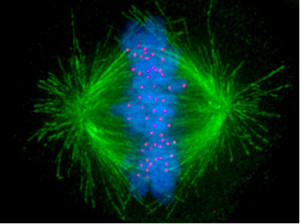Thank you for your contribution....

And of course the nucleus is even more amazing, containing most of the genetic information the cell carries. It is not only able to carry all that information accurately for decades, but is also able to duplicate it, and measure both time and cell divisions (by telomere erosion.) Having a limit to cell division is critical to preventing cancers. It also allows RNA transcription to occur; the RNA then moves along the reticulum to ribosomes where proteins are synthesized.
DNA is not a dynamic pattern. It is hardwired chemical information that is
copied by microtubules during mitosis. DNA only changes when mixed with the mate's DNA or by mutation, both becoming transcribed by MT, but not by storing sensory information.
So absolutely microtubules have a role in consciousness. Without them, neurons would die and we would lose consiousness (and die soon afterwards.) But that's true of everything else listed above. So while they are undoubtedly important, they are important solely because they allow the neurons that form our brains to work - not because they imbue the cells they inhabit with any inherent communicative properties.
But they do! MT are the ONLY communicative property a cell is imbued with. Every dendrite that is connected to the neural network is made from "shielded" microtubules (axons).
And they are pretty cool. But cooler than the foreign invaders that power our cells? More miraculous than the nucleus that stores hundreds of terabytes of information reliably for decades? Probably not
The point is that we are not talking about what keeps the body alive. Obviously all of our organs plus the 90% bacteria that convert chemicals for our benefit, keep us alive, else we would not possess them. None of that is being disputed.
But the argument that I need a cell nucleus in order to remember what I had for breakfast is problematic, IMO.
OTOH, we know that microtubules are the main processor and transport mechanism of dynamic sensory information. We know that MT pyramids store sensory information in dynamic "memory" mudules, which have absolutely nothing to do with DNA or RNA hardwired chemical
We know that information itself has no connection to "consciousness", the ability to process
dynamic sensory information as it is experienced. For that you need MT. Everything else is "information" being processed and directed to their proper destinations. The distribution network responsible for this is the MT and micro-fibrils, which makes it the natural candidate for being the platform in an emergent conscious experience of the sensory information being processed.
Roles of Cell Organelles in Mitosis
By Dr. Mary Dowd, Updated July 30, 2019
For the cell to live on and divide, organelles must be team players and work together with impeccable timing. Each organelle has an assigned job that contributes to cell stability and DNA replication through mitosis. Key organelles that make mitosis go as planned include the nucleus, mitotic spindle and microtubules. Checkpoints during the cell cycle help correct errors and prevent serious problems such as chromosome abnormalities
Organelles Involved in Cell Division
The nucleus is a like a locked safe where all instructions for cell growth are stored in the form of RNA and chromatin. In preparation for mitosis, genetic material increases in the nucleus. When mitosis starts, chromosomes condense, and the nuclear envelope around the nucleus disintegrates to free the chromosomes. The nuclear envelope reforms around the chromosomes after cell division, and the chromosomes return to the nucleus in anticipation of another cell cycle.
Microtubules are hollow, tubular proteins in the cell’s cytoskeleton that can expand and contract quickly depending on the cell’s needs. Microtubules work in tandem with motor proteins. As part of the spindle apparatus, microtubules help position, separate and pull apart chromosomes when the cell divides during mitosis.
When a cell prepares to make a copy of itself, cylindrical-shaped centrioles leave their post by the nucleus and head to opposite poles of the cell. Centrioles are microtubules that push out stringy fibers in a circular fashion, creating the appearance of a flowering aster. Centrioles in animals are thought to have a role in aligning and separating chromosomes; however, their function isn’t entirely clear since plant cells lack centrioles but still form spindle fibers.
https://sciencing.com/roles-cell-organelles-mitosis-22199.html
https://en.wikipedia.org/wiki/Soma_(biology)#/media/File:Neuron_Cell_Body.png
Note: all organelles in the cell produce information (stuff), except for the MT, which do not produce stuff but process and transport stuff throughout the body.
Note; a MT does not produce stuff but it can regulate it's own dynamic growth in accordance to the information that needs processing. IOW. MT is the only organelle that is able to adjust its own growth pattern (!!!!!) apart from any DNA instructions and adjust it's own electro-chemical properties to accommodate the transport of pertinent electro-chemical sensory information.
If we are looking for that which may be causal to "consciousness", MT are the only natural sensory information processing and distributing network, directly connected to the "senses" and the "brain", not the isolated organelles that produce specific electro-chemicals within a cell.






